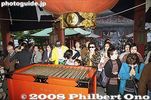 Image search results - "asakusabest" Image search results - "asakusabest" |

Year 628: Two fishermen brothers find a golden Kannon buddha statue in Sumida River. The two fishermen were Hinokuma no Hamanari and Takenari. A wealthy landowner named Hajinomatsuchi heard about the statue and told the brothers about its religious value.He then built a small temple for the statue and the brothers converted to Buddhism. The temple eventually became today's Sensoji Temple (also called Asakusa Kannon Temple). Because of the temple, Asakusa developed and prospered and the two brothers and landlord are considered to be the founders of Asakusa.
Next to Sensoji Temple is Asakusa Shrine dedicated to these three men now deified. Asakusa Shrine holds the annual Sanja Matsuri in May, one of Tokyo's biggest festivals. Three portable shrines dedicated to these three men are carried around the streets of Asakusa. "Sanja" means three shrines or gods.
檜前浜成(ひのくまのはまなり)・竹成(たけなり)の兄弟の網に一体の小さなご仏像がかかりました。
東京のあけぼの 浅草観音示現
|
|
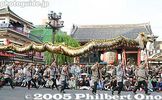
Golden Dragon Dance. No smoke or fire came out of the mouth. The dragon is 15 meters long, weighing about 80 kg. It has a bamboo frame, covered with cloth. Eight men use poles to manipulate the golden dragon.
|
|
|

Bull's eye. This is the third and last target along the course. It is quite difficult to hit all three targets, especially the last one.
|
|
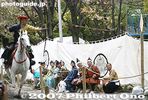
Arrow in mid-air. Asakusa Yabusame.
|
|
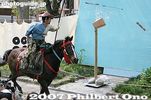
The wooden target boards have an envelope of confetti stuck on the back so it explodes when the target breaks apart.
|
|
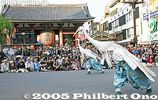
White Heron Dance in front of Kaminarimon Gate.
|
|
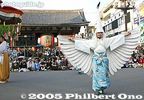
White Heron Dance
|
|

Shrine maiden and Kaminarimon Gate in Asakusa三社大権現祭礼 船渡御
|
|

Sankin Kotai Daimyo Gyoretsu 参勤交代 大名行列
|
|

Firemen's Acrobatics大岡越前守と江戸町火消
|
|
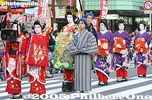
Oiran Dochu Procession. This is definitely the highlight of the festival, and my favorite part of the festival. 花の吉原おいらん道中
|
|

Oiran Dochu Procession in front of Kaminarimon Gate, Asakusa.花の吉原おいらん道中
|
|
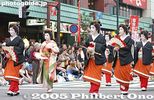
Edo Geisha. These geisha are from Asakusa, which also happens to be one of Tokyo's geisha districts. 江戸芸者
|
|
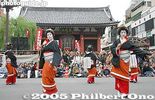
Edo Geisha江戸芸者
|
|

Edo Geisha江戸芸者
|
|

Edo Geisha江戸芸者
|
|

Symbol of Tokyo: Kaminari-mon Gate with a giant red paper lantern. Pass through this gate to reach Asakusa Kannon Temple. 雷門
|
|

Giant red paper lantern with the kanji characters "Kaminari Mon." The gate was reconstructed in 1960. The previous one was lost in a fire in 1865.
|
|

Nakamise-dori souvenir arcade. One of Japan's most popular and crowded tourist arcades.
|
|

Hozomon Gate, means "Treasure Storage Gate." Indeed, the second floor houses important cultural properties. The gate was reconstructed in 1964, a ferroconcrete building.宝蔵門
|
|

Behind Hozomon Gate is a pair of giant straw sandals hanging on the wall.
|
|

5-story pagoda reconstructed in 1973, made of ferroconcrete. Roof tiles made of aluminum alloy. 五重塔
|
|
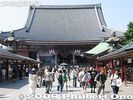
Hondo worship hall was reconstructed in 1958, made of ferroconcrete. The original Hondo was built in 1649 and a National Treasure until it was destroyed during World War II. 本堂
|
|

Incense burner
|
|

Incense burner. Pat the smoke to the part of your body that needs to be healed.
|
|

Hondo worship hall 本堂
|
|
|
|
|

View from Hondo worship hall
|
|
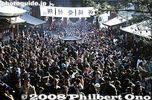
Crowd during New Year's
|
|

Inside Hondo worship hall 本堂
|
|

Hondo worship hall altar 本堂
|
|

Prayers in front of the altar and offertory box.
|
|

Asakusa Hagoita-ichi Battledore Fair, Dec. 17-19
|
|

Asakusa Hagoita-ichi Battledore Fair, Dec. 17-19
|
|
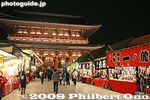
The Battledore Fair is held at night as well.
|
|
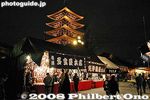
Battledore stalls and 5-story pagoda
|
|

Hozomon Gate paper lantern and hagoita stalls
|
|

At night
|
|

Yuka-chan, A.B.S.UNIDOS DO URBANA based in Nagoya at Asakusa Samba 2016.
|
|
|
|
|
|
|

Shirasagi-no-Mai dancer at Asakusa.
|
|

White Heron dancers were silent and sang nothing as the musicians played.
|
|

Shirasagi-no-Mai White Heron Dance at Asakusa.
|
|
|
|
|

The three-day Asakusa Sanja Matsuri is held during the weekend of the third Sunday of May. Numerous portable shrines (mikoshi) parade all over Asakusa amid huge crowds. Most of these photos were taken on May 17-18, 2008. (B/W ones taken some years ago.)
|
|

Asakusa Sanja Matsuri in front of Sensoji temple.
|
|

The mikoshi passes under Kaminarimon Gate, a symbol of Asakusa. The giant red lantern is collapsed upward to make room.
|
|
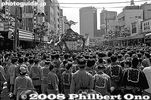
Kaminarimon-dori road during Sanja Matsuri
|
|

A mikoshi in front of Asakusa Shrine.
|
|

Above the Asakusa Tourist Information Center is this clock which opens and chimes every hour. This clock is no more since a new building for the tourist information center opened in April 2012.
|
|

Dolls representing three of Asakusa's most famous festivals appear. This is Sanja Matsuri. On the right, notice the foreign woman doll with blond hair.
|
|

White Heron Dance (Shirasagi no Mai).
|
|

Golden Dragon Dance (Kinryu no Mai).
|
|

The golden sculpture is atop the Asahi Beer building in Asakusa. It's supposed to be beer froth, but most people think it looks like doo-doo.
|
|
|
|




























